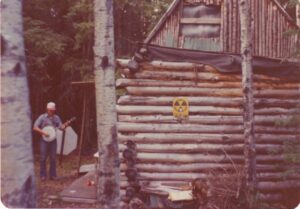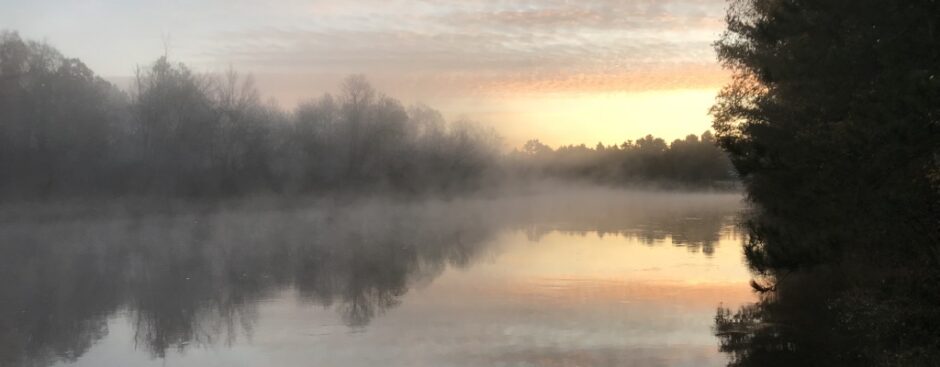
Jeff Tynjala at “The Cabin”
Most readers of this newspaper know that, as a non-Finn and a writer, I’m an affectionate Fennophile-a lover of all things Finnish. Long ago, as a kid growing up in NE MN surrounded by friends of Finnish background, I realized there was far more to innate Finnishness and being Finnish American/Finnish Canadian than a few remnant cultural touchstones. Much of that understanding is related to place, my home in Minnesota’s Northwoods and near the Mesabi Iron Range, the place my maternal Slovenian grandfather (Ivan “Jack” Kobe) immigrated to with his father and mother in the early 1900s. Great Grandfather Ivan, Grandpa Jack’s dad, was a blacksmith, working in open pit iron ore mines, settling in Aurora, MN, where he and his wife Anna raised six children: one born near the Slovenian-Croatian border (Jack) and the other five born on the Iron Range. All four Kobe sons spent time in the mines or working for the railroad (the Duluth, Missabe, and Iron Range: the line that hauls ore from the mines to the port cities of Duluth and Two Harbors, Minnesota).
My maternal grandfather’s odyssey mirrored that of many of the other immigrant young men of the time, including those who emigrated from Finland or were born to Finnish families in the New World. After completing eighth grade, Grandpa Jack went to work in the Black Hawk Mine as an ordinary miner but, given his intellect, sobriety, and dedication to task, eventually landed a job as a clerk in the mine office. That’s where he had consistent contact with the Finns employed in the mine, fellows who did the back-breaking, dirty, dangerous, day-to-day work of extracting natural iron ore from the ground. It’s also where he learned to speak Finnish. I never heard Grandpa Jack utter a word of Slovene, his native tongue. But I did, on the rare occasions when Jack’s dander was up, hear a few choice Finnish or Finnglish phrases wholly inappropriate for a child’s ears!
In high school, two of my Finnish American friends enlisted me, along with two other non-Finns, to build a log cabin in the woodlot of the old Tynjala farmstead in Makinen, an enclave of Minnesota Finnishness north of Duluth. The five of us worked in the woods, not cutting and squaring pine or tamarack (the choice trees had been logged off) but using thick, sixty-year-old second growth aspen for the walls and rafters of our crude teenage hideaway. As the building rose from the woods, the floor constructed of rough cut two-by-sixes “found” in the farm’s workshop and “borrowed” without permission, the roof sealed with tar paper rolled and nailed over plywood similarly “borrowed” from the site of I-35’s construction in Duluth, Grandpa Tynjala, himself a miner and logger and well into his seventies at the time, happened upon the project, took one look at the haphazard structure, leaned against the peeled aspen logs rising in the Minnesota summer air, and shook his head. “Boys, boys, boys,” he said evenly, “that’s not how it’s done.” That was it: no helpful criticism, no additional clues as to what we’d done wrong. He simply gifted us his opinion and wandered off.
Hunting ruffed grouse around the “cabin” (the charitable name we assigned to our hide-away), I marveled at the piles of rocks located throughout the dormant farm’s hayfield. Who the hell was crazy enough to farm this land? was a thought that stuck with me. Eventually, we grew up. The cabin, as predicted by Grandpa Tynjala, fell in upon itself, and life moved on. It wasn’t until, decades later when I was looking for a writing project (I’ve always a reader and a writer) I came across the story of Finnish everyman, Olli Kinkkonen, an immigrant murdered by thugs in Duluth for his refusal to fight in the Great War, that my interest in Finnish American history and culture manifested to the point it couldn’t be ignored.
My background as a lawyer, judge, writer, and historian compelled me to investigate Olli’s story, drew me into the world of those early immigrants (including my own Slovenian relatives) and eventually, Suomalaiset: People of the Marsh (the first book of what became my Finnish American trilogy) saw print. Being zero Finnish myself, I was hesitant to promote the book but, as luck would have it, a man affiliated with the New World Finn newspaper heard me on a local radio show talking about the story, called in, and left his number. Given I’m not a Finn, I was hesitant to engage. But I found my own sisu, dialed the number, and ended up having a lovely conversation with the paper’s editor. Gerry Henkel was largely responsible for turning my sleepy little story into a regional best seller. Gerry also introduced me to Finn Fest and a host of other venues where I’ve lectured and read from my work.
I ended up subscribing to NWF as well as FAR and enjoyed the differences between the publications. One aspect of NWF I came to appreciate was its focus on Finnish, Finnish American, and Finnish Canadian musicians, poets, writers, and artists. Those interviews and stories opened my eyes to the breadth of Finnish culture beyond what I’d gleaned through my own research and writing. Sadly, as with so many ethnic-based publications, NWF became a victim of our changing, digital, culturally assimilated world and ceased publication.
After the paper’s demise and with the onset of COVID, I found myself needing something to stay connected to the world. That’s when I approached Jim Kurtti, the editor of FAR, about doing online interviews of Finnish artists, musicians, writers similar to those I’d read in NWF. Jim gave me the “thumbs up” and to date, FAR has published over two-dozen interviews/articles of Finns, Finnish Americans, and Finnish Canadians involved in the arts and/or the preservation of Finnish and North American Finnish culture that I’ve penned. Jim’s successor at FAR, Dave Maki, has continued to request additional interviews and I’ve tried, as best as I can, to submit pieces in line with promoting the arts and culture of my Finnish friends.
In 2024, I was inspired to run for political office. I’ll not go into details of that experience here, but if you ask me over coffee, a beer, or a glass of wine, you might get me to spill the beans about what I went through. For the purposes of this piece, suffice it to say, I lost the election by the thinnest of margins and I’m ready to take up the keyboard again. But here’s the thing: I’m out of ideas. And that, my Finnish friends, is why I’m writing this essay for FAR. I know there are hundreds, maybe thousands, of Finns, Finnish Americans, or Finnish Canadians: gifted artists, poets, musicians, writers or folks working hard to preserve the culture of the Finns that would be of interest to you, the readers. I’d ask that you take a moment to suggest possible interview subjects via email. I can be reached at [email protected] and I’d love to hear from you.
I’m all out of ideas. So pull up a chair, fill your coffee cup, slice off some pulla, think things over, and email me the names and email addresses of folks I should interview. Don’t be shy: tell me why you believe that person or persons would make for an interesting story and, if appropriate, I’ll follow up on your suggestions. After all, it’s your newspaper and we’re all in this together!
Kiitos!
(c) 2025 Mark Munger (aka Markie Mungerin)


